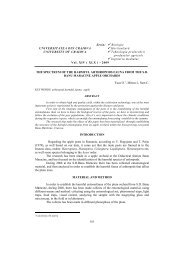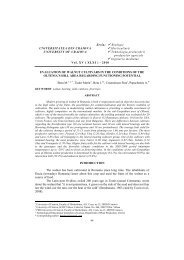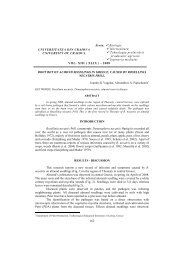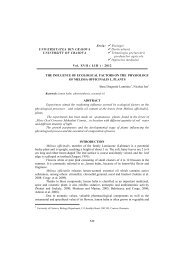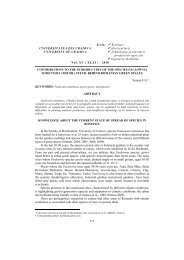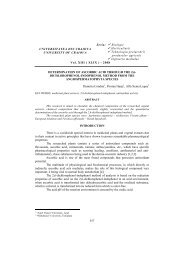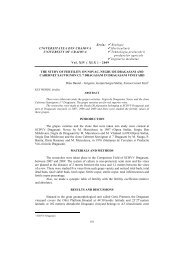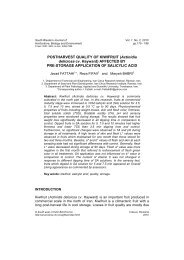You also want an ePaper? Increase the reach of your titles
YUMPU automatically turns print PDFs into web optimized ePapers that Google loves.
Seria: Biologie<br />
UNIVERSITATEA DIN CRAIOVA<br />
Horticultură<br />
UNIVERSITY OF CRAIOVA<br />
Tehnologia prelucrării<br />
produselor agricole<br />
Ingineria mediului<br />
Vol. XV ( XLXI ) - 2010<br />
EMBRIOLOGIC AND CYTOLOGIC STUDIES ON FRUIT SETTING IN WALNUT<br />
TREE (<strong>Juglans</strong> <strong>regia</strong> L.)<br />
KEY WORDS: walnut, apomixis, fruit, structure<br />
ABSTRACT<br />
Cosmulescu Sina 1 , Simeanu C. 1 , Achim Gh. 2<br />
Apomixis is an important characteristic of walnut. Fruit-setting through apomixis presents<br />
theoretical and practical importance; the embryo is homozygous and it loyally transmits the<br />
characters of mother plant. Research on apomictic formation of the embryo in walnut tree have been<br />
carried out in several countries; the mechanism of apomixis in walnut has been reported as<br />
adventitious embryony, apospory or diplospory. The paper aims at following-up the embryo<br />
development throughout its different stages, cell structure and development in walnut (fruits obtained<br />
by apomixis and by free pollination).<br />
INTRODUCTION<br />
Apomixis is an important feature of walnut, particularly in the northern cultivation<br />
areas (Loiko, 1990). Research carried out in walnut on fruit-setting have shown that some<br />
cultivars can generate fruits even without fecundation, through parthenocarpy or apomixis;<br />
but it was found out that fruit-setting is feeble, almost zero in some cases, while apomictic<br />
fruit-setting cannot be expected (Zhang et al., 2000;. Mu et al., 2001; Şan and Dumanoğlu,<br />
2006; Guoliang et al., 2007, 2010). Rate of apomictic fruits differs from year to year and<br />
depends on climate and variety (Asadian et al., 2005).<br />
Possibility of fruit-setting without pollination in walnut, under usual conditions,<br />
has raised special interest to researchers on flowering biology and seed formation. Sartorius<br />
and Stösser (1997) made the investigations aimed to explain the development of apomictic<br />
embryos by histological methods. Badalov (1989) also reported that apomictic embryos<br />
have developed mainly from the egg cell with subsequent doubling of chromosome<br />
numbers, leading to homozygosity. The mechanism of apomixis in walnut has been<br />
reported as adventitious embryony (Valdiviesso, 1990), apospory (Terziiski and Stefanova,<br />
1990), or diplospory (Sartorius and Stosser, 1991; Pintea, 2004). Ultrastructure of the<br />
fleshy pericarp and seed coat cells was systematically investigated by using transmission<br />
electron microscopy, and this study makes a significant contribution to our understanding<br />
of ultracellular events in developing walnut fruit (Wu et al., 2009). In Romania there were<br />
1 University of Craiova, Faculty of Horticulture, Al.I. Cuza street, no.13, 200585, Craiova<br />
2 University of Craiova, SCDP Vâlcea, Calea lui Traian Street, no. 464, 240273, Rm. Vâlcea<br />
* Corresponding author: sinacosmulescu@hotmail.com<br />
185
not found out any cultivars or hybrids to possess valuable characteristic of apomixis (Cociu<br />
et al., 2003).<br />
The aim of this study was to determine embryo development thougout different<br />
stages, structure and development of cells in walnut (fruits obtained by apomixis and by<br />
free pollination).<br />
MATERIALS AND METHODS<br />
Cultivars were used by including all types of dichogamy: protandry, protoginy,<br />
homogamy. To obtain apomictic fruits, flowers isolation with pergamin paper pocket was<br />
carried out before stigmata bifurcation; and pockets opening was carried out when stigmata<br />
were fully dried (Cociu et al. 1989). For cross sections of apomictic fruit and normally<br />
developed fruit, fruits were collected (Figure 1-3), then fixated in FAA fixator (80%<br />
ethanol: 10% glacial acetic acid: 10% formol) and then kept in the refrigerator. Cross and<br />
longitudinal sections were visualized by microscope and photographed.<br />
Figure 1-3: Fruits obtained by free pollination and apomictic fruits<br />
RESULTS AND DISCUSSIONS<br />
From cross sections made in apomictic fruits and freely polinated fruits, the<br />
folowing facts were found out:<br />
In 'Jupâneşti' cultivar (Figure 4), the cross section made through endocarp and seed<br />
-a fruit that is obtained by free pollination- showed that the unilayered skin lies at the<br />
exterior, equipped with a thick cuticle. Epicarp is made of 4-5 layers of cells that have<br />
colenchimatized walls. From place to place, at the limit between epicarp and mesocarp<br />
there are isolated cells or groups of large tanniniferous cells. Mesocarp is well developed; it<br />
is made of large spheroidal or ovoidal cells that contain numerous chloroplasts. In the<br />
mesocarp there are many conducive wood-free fascicles that are disorderly arranged and<br />
getting to the endocarp. Endocarp is made of small, parenchymatic cells that are<br />
tangentially elongated. There is no sclerification process in cells; the seed has thin<br />
tegument, made of 3-4 layers of small, parenchymatic cells that are slightly tangentially<br />
elongated. For the rest, the seed is made of spheroidal or ovoidal cells that are slightly<br />
larger than those in the tegument, but they do not have reserve substance at the interior.<br />
These cells have small intercellular spaces.<br />
In apomictic fruit (Figure 5), 'Jupâneşti' cultivar, epidermis is unilayered and<br />
equipped with thick cuticle. Tanniniferous cells go inside the mesocarp. Epicarp is made of<br />
2-3 layers of cells with slightly colenchimatized walls, and underneath there are numerous<br />
tanniniferous cells, some of them large and radially elongated that are goign inside the<br />
mesocarp. Mesocarp is made of spheroidal and ovoidal cells, with small spaces between<br />
them, and numerous chloroplasts at the interior. In the mesocarp there are conducive woodfree<br />
cells that are smaller than in pollinated form; and they are located somehow orderly on<br />
186
two circles; one is located under the epicarp, while the other is located at the exterior of<br />
endocarp; and in other areas they are disorderly arranged. Endocarp is made of 2-3 layers of<br />
cells with thin walls, slightly elongated tangentially. There is no sclerification process<br />
observed in cell walls. Seminal tegument cannot be seen in the seed; the cells located<br />
underneath the endocarp -that belong to the seed- do not contain any stored reserve<br />
substance at the interior.<br />
Figure 5: 'Jupâneşti'<br />
cultivar (apomictic fruit),<br />
cross section made through<br />
endocarp and seed (40x10)<br />
Figure 4: 'Jupâneşti'<br />
cultivar (pollinated fruit),<br />
cross section made through<br />
endocarp and seed (40x10)<br />
Figure 7: General view – in<br />
'Jupâneşti' cultivar<br />
(apomictic fruit) (4x10)<br />
Figure 6: General viewepicarp,<br />
mesocarp,<br />
endocarp and seed in<br />
'Jupâneşti' cultivar (4x10)<br />
Figure 8: Tanniniferous<br />
cells, in 'Jupâneşti' cultivar<br />
(apomictic fruit) (40x10)<br />
Figure 9: Epidermis,<br />
epicarp, mesocarp in<br />
'Fernet' cultivar (apomictic<br />
fruit) (40x10)<br />
General view (Figure 6) – epicarp, mesocarp, endocarp and seed in 'Jupâneşti'<br />
cultivar; fruit is obtained by natural pollination; and general view (Figure 7) – epicarp,<br />
mesocarp, endocarp and seed in 'Jupâneşti' cultivar, with apomictic fruit. In apomictic fruit<br />
there are tanniniferous cells; they are radially elongated, of spherodial and ovoidal shape,<br />
which go deeply into mesocarp (Figure 8).<br />
In 'Fernet' cultivar, the cross section through epidermis, epicarp and part of<br />
mesocarp through apomictic fruit (Figure 9), has uni-layered epidermis equipped with very<br />
thin cuticle, and numerous pluricellular hairs that are elongated and club-shaped. The fruit<br />
is during the period right after fecundation (black-coloured stigmata). During this stage of<br />
development, the epicarp is poorly differentiated, made of 4-5 layers of cells with thin<br />
walls; the cells are slightly elongated tangentially. Mesocarp is made of spheroidal and<br />
ovoidal cells, without chloroplasts at the interior. Conducive fascicles are under<br />
differentiation stage, and they are disorderly arranged. Endocarp is not differentiated and<br />
one cannot see the difference between mesocarp, endocarp and seed. In some areas the<br />
internal epidermis of the ovar can be observed.<br />
187
In conclusion, embriologic and cytologic studies are outlining the different stages<br />
in the embryo’s development. Further precise studies are required to outline morphological<br />
differences between apomictic and pollinated fruits.<br />
ACKNOWLEDGEMENTS<br />
This paper is carried out as a result of the research contract CNCSIS –<br />
UEFISCSU, the project: PNII – IDEI code 430 /2008.<br />
BIBLIOGRAPHY<br />
Asadian G., Pieber K. 2005. Morphological Variations in Walnut Varieties of the<br />
Mediterranean Regions. International journal of agriculture & biology, 7(1): 71-73.<br />
Badalov P.P. 1989. Use of Apomixis for the Production of New Varieties of Walnut.<br />
Tezisy Dokladov, Sostoyanie i Perspektivy Razvitia Promyshlennogo Orakhovodstva,<br />
Moscow.<br />
Cociu V., Vasilescu V., Parnia P., Godeanu I., Onea I. 1983. Cultura nucului. Editura<br />
Ceres, pg 34-35.<br />
Guo-Liang W., Yan-Hui C., Peng-Fei Z., Yang Jun-Qiang Y., Yu-Qin S. 2007.<br />
Apomixis and new selections of walnut. Acta Hort. (ISHS) 760:541-548.<br />
Guoliang W., He L., Qunlong L., Yong W., Pengfei Z. 2010. ‘Qinquan 1’, a new<br />
apomixis walnut cultivar. Fruits, 65:39-42.<br />
Loiko R.E. 1990. Apomixis of walnut. Acta Hort. (ISHS) 284:233-236.<br />
Mu X.J., Cai X., Sun D.L. 2001. Apomixis and its application prospect of angiosperm.<br />
Acta Agric. Sin. 27:590-598.<br />
Pintea M. 2004. Nucul. Biologia reproductiva. Chisinau.<br />
Sartorius R., Stosser R. 1991. Apomictic seed development in walnut (<strong>Juglans</strong> <strong>regia</strong>).<br />
Angew. Bot., 65: 205-218.<br />
Sartorius R., Stösser R. 1997. On the apomictic seed development in the walnut<br />
(<strong>Juglans</strong> <strong>regia</strong> L.). Acta Hort. (ISHS) 442:225-230.<br />
Şan B., Dumanoğlu H. 2006. Determination of the Apomictic Fruit Set Ratio in Some<br />
Turkish Walnut (<strong>Juglans</strong> <strong>regia</strong> L.) Genotypes. Turkish journal of agriculture and forestry,<br />
30 (3): 189-193.<br />
Terziiski D., Stefanova A. 1990. Nature of apomixis in some Bulgarian varieties of<br />
walnut (<strong>Juglans</strong> <strong>regia</strong> L.). Rasteniev'dni Nauki, 27:73-77.<br />
Valdiviesso T. 1990. Apomixis in Portuguese walnut varieties. ActaHort. 284: 279-<br />
283.<br />
Wu G.L., Liu Q.L., Teixeira da Silva J.A. 2009. Ultrastructure of pericarp and seed<br />
capsule cells in the developing walnut (<strong>Juglans</strong> <strong>regia</strong> L.) fruit. South African Journal of<br />
Botany, 75 (1):128-136.<br />
Zhang M.Y., Xu Y., Ma F.X. 2000. Study on the apomixis ability of walnut (<strong>Juglans</strong><br />
<strong>regia</strong>) varieties. J. Fruit Sci., 17: 314-316.<br />
188



